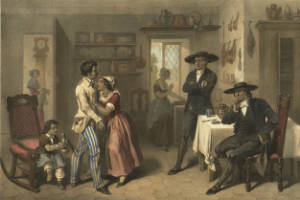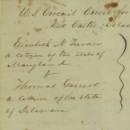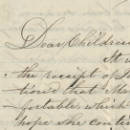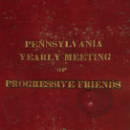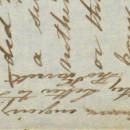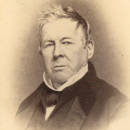
Thomas Garrett
By Mariah Parker
Swarthmore College Class of 2013
General Introduction
Thomas Garrett is known as one of the most active and most influential stationmasters on the Underground Railroad. Garrett served as a stationmaster for more than four decades, and it has been claimed that Garrett helped 2,700 enslaved people on their journey to freedom. Thomas Garrett even served as the inspiration for the character Simeon Halliday in Harriet Beecher Stowe's influential novel Uncle Tom's Cabin.
Thomas Garrett was born in Upper Darby, Pennsylvania on August 21st, 1789. He was the son of Thomas and Sarah Price Garrett, and was a member of the Darby Monthly Meeting of the Religious Society of Friends.
Garrett became dedicated to the antislavery cause in 1813, after rescuing a free African-American servant of the Garrett family who was kidnapped by slave traders. He also married Mary Sharpless in 1813. In 1822, he moved to Wilmington, Delaware and transferred his membership to the Wilmington Monthly Meeting. Wilmington was a growing city that offered Garrett new business opportunities. However, Wilmington was also the northernmost town in the slave state of Delaware, and the last city before the relative security of Pennsylvania. After moving to Wilmington, Garrett went into "the iron and hardware business" and opened his home at 227 Shipley Street as a station on the Underground Railroad (McGowan 38).
Mary Sharpless died in 1828. In 1830, Garrett married Rachel Mendenhall, the daughter of Pennsylvania abolitionist Eli Mendenhall.
In 1848, Thomas Garrett was put on trial for helping the Hawkins Family of Queen Anne's County, Maryland, in their flight from slavery (see Introduction to the Trial of 1848). Due to a combination of business reverses and fines, he lost nearly all of his possessions, but he managed to regain his financial standing.
Thomas Garrett died on January 25, 1871. He is buried at the Wilmington Friends Meeting House in Wilmington, Delaware.
Introduction to the Trial of 1848
In December, 1845, The Hawkins family escaped from Queen Anne's County, Maryland. The father, Samuel Hawkins, was a free man, but his wife Emeline and six children were enslaved. The two oldest children belonged to Charles Glanding, and Emeline and the other four children belonged to Elizabeth Turner. The Hawkins family was captured by slavehunters while hiding at the Underground Railroad Station of John Hunn, and taken to the New Castle County Jail. The sheriff, Jacob Caulk, told the slavehunters that the commitment that they had obtained to imprison the Hawkins family was not legal, and that they had to get a new commitment. Meanwhile, Thomas Garrett learned of the family's plight, and brought the fugitives before Judge Booth (Chief Justice of the state of Delaware) on a writ of habeas corpus. Judge Booth ordered the family's release. Garrett ordered a coach for the fugitives, and sent them to Pennsylvania.
In May of 1846, Thomas Garrett and John Hunn received summonses. The owners of the Hawkins family brought the abolitionists to trial under the Fugitive Slave Act of 1793. There were six trials: John Hunn was involved in two and Thomas Garrett was involved in four. The trials took place in the U.S. Circuit Court in Delaware. Roger B. Taney, the Chief Justice of the Supreme Court who would later deliver the majority opinion in the Dred Scott case, presided over the trials.
1. Friday, May 26: Charles Glanding sued Thomas Garrett for debt. The jury ruled in favor of Glanding, and assessed a fine of $1,000.
2. Saturday, May 27: Elizabeth Turner sued Thomas Garrett for debt, for the amount of $2,500. The jury ruled in favor of Turner.
3. Monday, May 29: Charles Glanding sued Garrett for trespass, for $2,000. The jury ruled in favor of Glanding, but only assessed damages of $1,000.
4. Monday, May 29: Elizabeth Turner sued Thomas Garrett for trespass, for the amount of $5,000. The jury ruled in favor of Turner, but only assessed damages of $900.
Thomas Garrett was fined a total sum of $5,400.
The Friends Historical Library's Collection has a set of notes taken at Thomas Garrett's trial. The notes are divided into three sections: witness testimonies in the cases of Turner vs. Garrett and Glanding vs. Garrett, and the final rulings against Garrett.
References
McGowan, James A. Station Master on the Underground Railroad: The Life and Letters of Thomas Garrett, rev. ed. Jefferson, N.C.: McFarland & Co., 2004.
"More Slaveholding Law, and Slaveholding Outrages!" Pennsylvania Freeman V:22 (1 June 1848), p. 3.
Still, William. The Underground Railroad. New York: Ayer, 2004. [Reprint of Philadelphia: Porter & Coates, 1872 ed.]
Stowe, Harriet Beecher. The Key to Uncle Tom's Cabin. New York: Arno Press, 1968. [Reprint of 1854 ed.]
"Thomas Garrett and John Hunn." Pennsylvania Freeman V:23 (8 June 1848), p. 3.
Thomas Garrett Biographical Materials, Friends Historical Library of Swarthmore College, PG7 Garrett.

